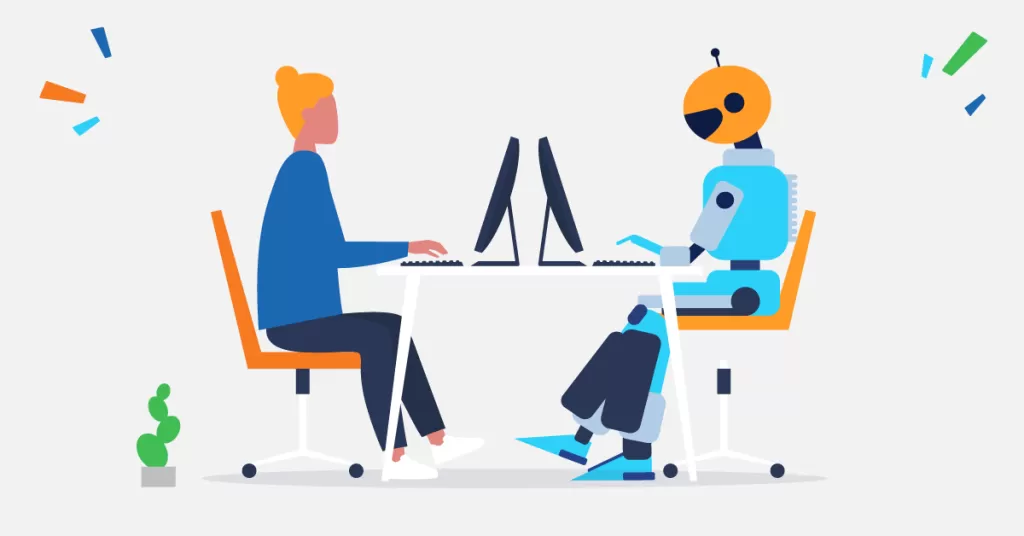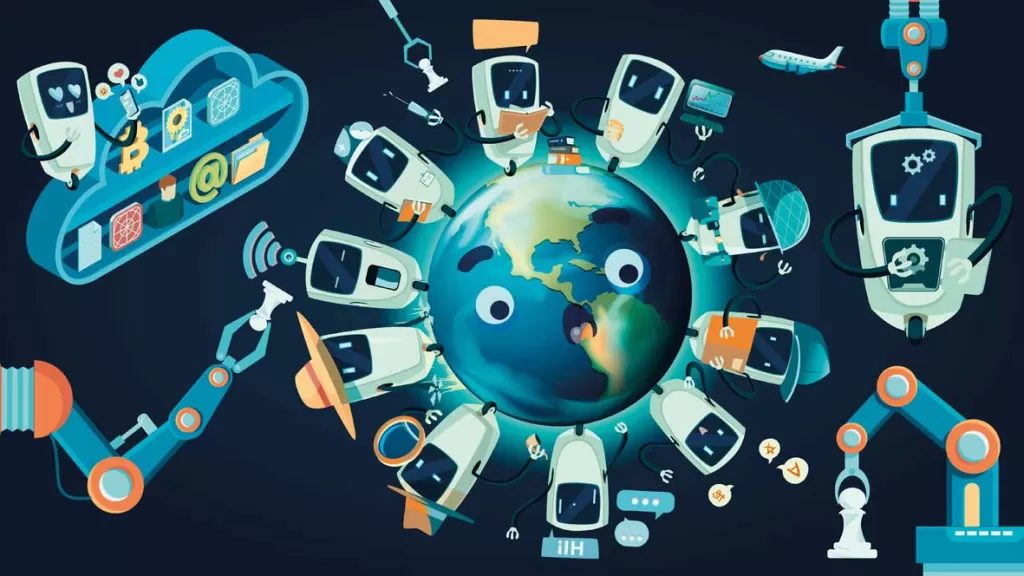Written By:
Scott McAuley
Scott is the IT Director of Texas Management Group, and has been in the IT industry for 25 years.
Rapidly advancing artificial intelligence is radically rewriting the future of the modern workplace with unparalleled chances for innovation and efficiency.
Businesses, with the increasing integration of AI and the Future of Work into the operations of their units, have changed the face of the workplace. From automating tedious tasks to enriching decision-making processes, AI has rapidly become the vital tool that equips employees and transforms organizational performance.
In this article, we shall look through how AI is transforming the future of work, what types of AI are being used in work, where AI is already in use, and the radical advantages it brings into the workplace.
Let’s get right into it.
Key Takeaways
- AI is revolutionizing the workplace by automating tedious tasks and enhancing decision-making processes. It serves as a vital tool that equips employees and boosts organizational performance, fostering innovation and efficiency.
- AI encompasses various technologies such as Natural Language Processing, Computer Vision, and Robotics. These technologies enable machines to understand human language, interpret visual data, and perform complex tasks, thus amplifying human capabilities across diverse industries.
- AI is reshaping job prospects by automating routine tasks and creating demand for new roles like AI trainers and ethics advisors. This transformation necessitates learning new skills, fostering human-machine collaboration, and embracing lifelong learning to stay competitive.
- Key AI technologies like Machine Learning, Natural Language Processing, and Robotic Process Automation are enhancing workplace productivity. They improve tasks such as fraud detection, customer segmentation, data entry automation, and medical imaging analysis.
- AI is extensively used across various sectors such as customer service, human resources, finance, and healthcare. Applications include AI-powered chatbots, predictive analytics, fraud detection systems, and personalized learning platforms, all contributing to improved efficiency and decision-making.
Table of Contents
What is AI?

Artificial Intelligence is rapidly changing the way we live and work by making machines smart. AI means the creation of advanced systems and algorithms that handle vast volumes of data. They can find patterns and make decisions from it. With machine learning, one of the parts of AI, these systems become better and more effective over time.
AI has different areas, each focusing on aspects of human intelligence. Natural Language Processing (NLP) lets machines understand and generate human speech, like virtual assistants. Computer vision helps machines interpret visual data, which is used in things like facial recognition and self-driving cars. Robotics combines AI with physical machines, allowing them to do complex tasks.
AI does not exist only in the technological sphere; the effect of artificial intelligence goes far beyond. Artificial intelligence automates routine work and amplifies human capability, helping businesses run smoother, more productive, and based on data-informed decision-making.
How is AI Impacting the Workforce?
Artificial intelligence (AI) is fast-changing job prospects. It is changing work in critical ways and demanding new skills for the evolving market. As AI technologies become more advanced and pervasive, so will our understanding of work and the skills that one needs to be successful.
The first major impact that AI is having is in displacing jobs. It uses algorithms to make tasks automatic, in fact, most in the areas of manufacturing, retail, and customer service. Such a change takes some of the jobs away from people as machines can do them more efficiently and quickly.
But AI also opens new doors for jobs. The demand for AI professionals is growing rapidly. AI trainers, maintenance technicians, and ethics advisors are just some of the jobs that are emerging in the market. They ensure AI is used responsibly and effectively.
This transformation will require learning new skills. Workers and organizations should invest in training and education that keeps people competitive in the AI-driven job market.
Another significant change is the increased human-machine collaboration. AI is not replacing human beings but enabling them to be more creative and work in tandem, ensuring precision and new capabilities. Together, this partnership drives better innovation and productivity.
- Embrace lifelong learning and continuously update your skills to stay relevant in the evolving job market.
- Develop a deep understanding of AI technologies and their potential applications in your industry.
- Cultivate a mindset of adaptability and be open to new roles and opportunities that emerge as a result of AI adoption.
- Focus on developing uniquely human skills, such as critical thinking, emotional intelligence, and creativity, which are less likely to be automated.
- Actively seek out opportunities to collaborate with AI systems and leverage their capabilities to enhance your own work.
| Industry | AI Impact | Upskilling/Reskilling Needs |
|---|---|---|
| Manufacturing | Automation of assembly lines and quality control | Training in robotics, AI-assisted manufacturing, and data analysis |
| Healthcare | AI-powered diagnostics and personalized treatment plans | Education in AI-assisted medical technologies and data interpretation |
| Finance | AI-driven fraud detection and algorithmic trading | Upskilling in AI-based financial analysis and risk management |
| Retail | AI-powered customer service and personalized recommendations | Training in AI-assisted sales techniques and customer experience management |
Proactive strategies and a willingness to learn are the only ways to succeed in an AI-disrupted job market. Adopting skill updates, encouraging human-machine collaboration, and implementing visionary approaches will ensure success in the AI-shaped future of work.
10 Types of AI Used in Work
Artificial intelligence is transforming the workplace through its tools and technologies. It improves efficiency, accuracy, and decision-making. Machine learning algorithms, for instance, are applications that improve over time. They use historical data to identify trends, predict outcomes, and improve process efficiency. This improves performance in fraud detection, customer grouping, and demand forecasting.
Here are the key types of AI used in work, each contributing uniquely to enhancing productivity, efficiency, and innovation:
| AI Type | Key Characteristics | Applications |
|---|---|---|
| Machine Learning | Learns from data, improves performance over time | Fraud detection, customer segmentation, demand forecasting |
| Natural Language Processing | Understands and generates human language | Chatbots, sentiment analysis, language translation |
| Robotic Process Automation | Automates repetitive tasks using software robots | Data entry, form filling, invoice processing |
| Computer Vision | Interprets visual information from images and videos | Facial recognition, object detection, medical imaging analysis |
| Expert Systems | Emulates human decision-making in specific domains | Healthcare diagnostics, financial analysis, engineering problem-solving |
| Speech Recognition | Converts spoken language into written text | Virtual assistants, voice-controlled devices, transcription services |
| Autonomous Systems | Operates independently based on AI algorithms | Self-driving vehicles, drones, robotics |
| Recommendation Systems | Provides personalized suggestions based on user data | E-commerce, streaming services, social media platforms |
| Reinforcement Learning | Learns optimal decision-making through rewards and punishments | Robotics, gaming, optimization problems |
| Artificial Neural Networks and Deep Learning | Enables complex pattern recognition and feature extraction | Image classification, speech recognition, natural language understanding |
1. Machine Learning (ML)
Machine learning algorithms are thus the foundation of AI, allowing systems to improve their performance over time. They use data rather than manual programming to identify patterns, forecast, and fine-tune processes. This improves efficiency and precision in tasks such as detecting fraud, segmenting customers, and predicting needs.
2. Natural Language Processing (NLP)
Natural language processing, in its turn, builds the bridge connecting computers with human language. It allows computers to analyze and generate both text and speech. The technology underlies chatbots, sentiment analysis tools, and language translation systems. It automates customer support, monitors brand perception, and enables communication in many languages.
3. Robotic Process Automation (RPA)
Robotic process automation tackles the segment of repetitive, rule-based jobs by using software robots imitating human tasks. The processing of data entry, filling forms, and invoice handling are some of the activities tackled by RPA. This enables staff to be free for work requiring human ingenuity. It reduces costs, cuts down on errors, and increases overall productivity by automating commonplace activities.
4. Computer Vision
Computer vision enables machines to interpret visual data from images and videos. It powers facial recognition software, object detection systems, and medical image analysis. It uses automated inspection, inventory tracking, and medical diagnosis to transform industries such as retail, healthcare, and manufacturing.
5. Expert Systems
The AI programs are known as expert systems and may imitate the decision-making prowess of human experts for a narrow domain. They rely on an extensive knowledge base and logic in order to provide recommendations, diagnoses, or even problem solutions. Used almost everywhere in health, finance, and engineering to help professionals make insight-driven decisions, they are beneficial when complex problems are to be addressed.
6. Speech Recognition
Speech recognition is the process through which spoken words are transformed into text. It enables voice-activated interfaces and transcription services. Due to deep learning and neural networks, these systems have become more accurate and versatile. Underpinning virtual assistants, smart devices, and call center solutions, they make communications more accessible and efficient.
7. Autonomous Systems
Autonomous systems, such as self-driving cars and drones, work independently. They use AI to sense the environment around them, make decisions, and act on those decisions. Such systems, equipped with sensors and computer vision further enhanced by the use of advanced algorithms, execute in a variety of environments to show the might of AI in autonomy.
8. Recommendation Systems
Recommendation systems analyze user data to offer personalized suggestions. Such systems consider user behaviors, including clicks and ratings, to predict preferences. These systems are central in e-commerce, streaming, and social media. They improve engagement and sales by suggesting content or products tailored to individual tastes.
9. Reinforcement Learning
Reinforcement learning works with agents that attempt to make optimal decisions over time. They are rewarded or penalized based on their actions. This system enables machines to learn from past experiences and adjust their strategy to maximize future rewards. This is useful, for example, in fields like robotics and gaming, where consistent optimal decisions are required.
10. Artificial Neural Networks (ANNs) and Deep Learning
Artificial neural networks are patterned after the architecture and function of a human brain. They are a network of interconnected nodes that process and share information. Deep learning, within this framework, uses multiple layers to extract features from data automatically. It does particularly well at such tasks as image classification, speech recognition, and natural language understanding—new benchmarks in these respective tasks.
Current Applications of AI in Work
Across various industries, Artificial Intelligence (AI) is sparking a revolution in how we work. It streamlines processes, improves decision-making, and boosts efficiency.
Here are some of the current applications of AI in work:
| Industry | AI Applications |
|---|---|
| Customer Service | Chatbots, Virtual Assistants |
| Human Resources | Resume Screening, Candidate Matching, Employee Engagement Analysis |
| Sales and Marketing | Lead Generation, Personalized Recommendations, Sentiment Analysis |
| Operations and Supply Chain Management | Demand Forecasting, Route Optimization, Inventory Management |
| Finance | Fraud Detection, Risk Assessment, Algorithmic Trading |
| Healthcare | Medical Imaging Analysis, Drug Discovery, Personalized Treatment Planning |
| IT and Cybersecurity | Threat Detection, Network Monitoring, Automated Incident Response |
| Manufacturing | Predictive Maintenance, Quality Control, Robotics |
| Legal Services | Document Review, Contract Analysis, Case Prediction |
| Education and Training | Personalized Learning, Adaptive Assessments, Intelligent Tutoring Systems |
| Creative Industries | Generative Art, Music Composition, Content Creation |
| Administrative Tasks | Document Processing, Scheduling, Email Management |
1. Customer Service
Artificial intelligence-equipped chatbots and virtual assistants redefine customer service by providing personalized support to customers 24/7. They effectively handle large volumes of customer inquiries, providing instant responses. In so doing, it leaves human representatives a chance to deal with highly complex interactions, thus enhancing customer service in general.
Example:
- Chatbots and Virtual Assistants: AI-powered chatbots provide instant responses to customer inquiries, offering 24/7 support and reducing the workload on human agents.
- Sentiment Analysis: Analyzing customer feedback and social media interactions to gauge sentiment and improve customer service strategies.
2. Human Resources
Artificial intelligence is applied to human resources when it comes to resume scanning and identification of the best candidates. It provides insights into employee engagement and predicts turnover. This allows HR departments to nurture top talent, refine recruitment strategies, and work on developing targeted programs to keep their best people.
Example:
- Recruitment and Hiring: AI algorithms screen resumes, match candidates to job descriptions, and even conduct initial interviews.
- Employee Engagement: Analyzing employee data to identify factors affecting engagement and productivity, and suggesting interventions.
3. Sales and Marketing
AI enables targeted lead generation and improves customer engagement in sales and marketing. In-depth analysis of customer data is used to provide customers with personalized product recommendations and optimize pricing, and customer sentiment is measured to adjust marketing strategies and strengthen brand loyalty.
Example:
- Predictive Analytics: Forecasting sales trends, customer behaviors, and market demands to tailor marketing strategies.
- Personalized Marketing: Using AI to deliver personalized content and product recommendations to customers based on their browsing and purchase history.
4. Operations and Supply Chain Management
AI modernizes operations and supply chains with its predictive capabilities. It forecasts demand, optimizes delivery routes, and avoids supply chain blockages. This streamlines processes, reduces waste, and enhances efficiency across the board.
Example:
- Inventory Management: AI predicts inventory needs based on historical data and market trends, ensuring optimal stock levels.
- Logistics Optimization: Enhancing route planning, delivery schedules, and overall supply chain efficiency.
5. Finance
In finance, AI sharpens the systems for fraud detection and evaluation of risk, hence providing data-driven investment decisions. Scanning financial data, it picks out suspicious transactions and evaluates credit. Such AI systems help financial institutions stay compliant, reduce their risk, and improve returns on investment.
Example:
- Fraud Detection: AI systems monitor transactions in real-time to detect and prevent fraudulent activities.
- Automated Trading: Algorithms execute trades at high speed and efficiency, optimizing investment strategies.
6. Healthcare
AI improves healthcare by allowing for faster and more accurate diagnoses, as well as personalized patient care plans. It examines health data to identify health risks and personalize treatments. As a result, diseases are detected earlier, care is provided more effectively, and overall health improves.
Example:
- Diagnostic Assistance: AI analyzes medical images, scans, and patient data to assist doctors in diagnosing diseases.
- Personalized Medicine: Tailoring treatment plans based on individual patient data and genetic profiles.
7. IT and Cybersecurity
In IT and cybersecurity, AI is indispensable for real-time threat detection and prevention. It analyzes network data to keep systems safe from evolving cyber threats. Organizations use AI to improve their security, protecting sensitive information from unauthorized access.
Example:
- Network Monitoring: AI systems continuously monitor network traffic to detect anomalies and potential security threats.
- Automated IT Support: AI-powered tools diagnose and fix common IT issues, providing quick resolutions to technical problems.
8. Manufacturing
AI is changing manufacturing with predictive maintenance and quality checks. It inspects the products, ensuring they meet high standards, and automates many repetitive tasks to enhance production efficiency and maintain quality throughout.
Example:
- Quality Control: AI-driven visual inspection systems detect defects and ensure product quality.
- Predictive Maintenance: Predicting equipment failures before they occur, minimizing downtime and maintenance costs.
9. Legal Services
AI also assists the legal field in document review and legal research, automating the tasks of contract analysis. It goes through legal documents in search of important information to help lawyers in their work. This makes decision-making faster and helps in reducing the workload, thus streamlining the legal processes.
Example:
- Document Review: AI algorithms review and analyze legal documents, contracts, and case files, speeding up the research process.
- Predictive Case Analysis: Analyzing past case outcomes to predict the potential success of current legal cases.
10. Education and Training
AI improves educational teaching by personalizing learning and keeping educators up to date on student performance. It customizes content based on how students learn and assists teachers in refining lessons to suit the students better.
Example:
- Personalized Learning: AI-driven platforms customize educational content to fit individual learning styles and paces.
- Virtual Tutors: Providing students with real-time assistance and feedback on their assignments and coursework.
11. Creative Industries
In the creative domain, AI is helpful for generating art and music. It analyzes the creative data and produces unique designs and compositions. That way, it would allow creators to explore new realms artistically, making their work richer with new ideas.
Example:
- Content Creation: AI tools assist in generating written content, music composition, and even visual art.
- Video Editing: Automating the editing process to enhance video production efficiency.
12. Administrative Tasks
In the creative domain, AI produces art and music. It analyzes creative data and produces original designs and compositions. It helps creators to dive into new dimensions of creativity, making their work richer with new ideas.
Example:
- Scheduling: AI-powered virtual assistants manage calendars, schedule meetings, and coordinate appointments.
- Data Entry: Automating repetitive data entry tasks, reducing errors and freeing up time for more strategic activities.
As AI continues to evolve, so will its place in the workplace. The companies that embrace AI and put it to good use will lead their competition by a mile in their efficiency and innovation. Ethics, privacy, and human oversight should be concerns these businesses take into account. By applying AI intelligently, new doors can be opened for them to take part in shaping the future of work.
Preparing for AI and the Future of Work
AI is transforming the way we work. Effective transition necessitates a combination of proactive measures. Upskilling and reskilling initiatives are, arguably, central to it all. That is because they are workers with the skills required for an AI-centric world. Lifelong learning investment keeps them ahead of market demands.
Workforce programs must focus on the fundamentals of AI. Such knowledge enables individuals to collaborate better with AI tools. AI ethics are also important for ensuring that AI is used safely and fairly, thereby reducing risks and bias.
During job changes, it’s critical to have strong support systems in place. This could mean:
- Guidance and help with finding new career paths
- Financial aid and unemployment benefits for those in transition
- Opportunities for learning new skills fitting emerging market needs
- Support for starting independent ventures
Getting through work changes will need an all-hands-on-deck approach. Employers, schools, and policy makers must collaborate. Their focus should be:
- Spotting skill shortages and crafting the right training programs
- Building learning pathways specific to various industries
- Making learning a life-long pursuit with easy, adjustable formats
- Putting in place policies that aid in job changes and provide a safety net
Conclusion
As we look into the still-unknown potential of AI and the future of work, it is evident that change is not an option but rather a necessity. AI presents challenges and opportunities; it calls for adaptability and growth with it. Even though the loss of jobs in some sectors is a significant concern, the possibility of creating new jobs and enhancing efficiency to the maximum level is enormous.
This requires a proactive approach to be taken in this era. It involves new skill acquisition and adaptation to human-machine collaboration through lifelong learning. The development of good AI ethics and governance to handle AI wisely and minimize risks is necessary, ensuring responsible application of AI.
Having placed human needs first and incorporated the benefits of AI, we can look ahead with confidence into an unknown future. With hard work and a clear vision, we can turn the future of work into a place that is rewarding for all.
Now, learn more about AI and what the future of work looks like with texmg.com! If you liked this article, you’d appreciate our other thought-provoking blogs. Keep reading because there’s more: get insight into more with us. Plus, while you are here, learn about our competitively priced IT Services that will bring your business to the next level. Welcome to transformation with texmg.com!
Curious About AI’s Role in Reshaping the Workplace?
Uncover insights in our blogs on AI advancements, and see how our IT Consulting Services can guide your business through transformation.
Embrace the future with confidence!
FAQ
How Will AI Affect the Future of jobs?
AI will automate routine tasks, create new job opportunities in tech fields, and enhance productivity, requiring workers to adapt and learn new skills.
What jobs Will AI Replace in the Future?
AI is likely to replace jobs involving repetitive tasks, such as data entry, manufacturing, and certain administrative roles, while also transforming others.
How can AI Change the Nature of Work?
AI can change the nature of work by augmenting human capabilities, enabling remote work, enhancing decision-making processes, and fostering collaboration between humans and machines.
How is AI Going to Change the Workforce?
AI will change the workforce by increasing demand for tech-savvy professionals, necessitating continuous learning and upskilling, and potentially reducing the number of traditional, routine jobs.






